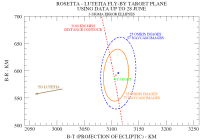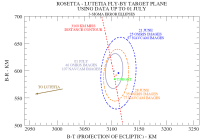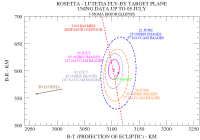No. 140 - Rosetta on track towards asteroid Lutetia
Based on the navigation data the reserved slot for a possible trajectory correction manoeuvre in this reporting period, at 1 week before the closest approach, was found to not be needed. The spacecraft is perfectly on track for the asteroid flyby and if the navigation results remain stable no further correction manoeuvre will be required.
During the reporting period, mission operations have been conducted with support of the ESA New Norcia (NNO) ground station. Additional tracking passes were performed with the NASA DSN ground stations in Goldstone (DSS-24) and Madrid (DSS-54), as part of the navigation campaign for asteroid Lutetia:
| DOY | Date | Pass | Main Activity |
| 179 | 28/06/10 |
NNO 2315 |
Optical navigation slot 8 |
| 180 | 29/06/10 |
NNO 2316 |
Optical navigation slot 9 |
| 181 | 30/06/10 |
NNO 2317 |
Optical navigation slot 10 |
| 182 | 01/07/10 |
NNO 2318 |
Optical navigation slot 11 |
| 183 | 02/07/10 | DSS-24 2319 NNO 2319 DSS-24 2320 |
Optical navigation slot 12 |
| 184 | 03/07/10 |
NNO 2320 |
Optical navigation slot 13 |
| 185 | 04/07/10 |
NNO 2321 |
Optical navigation slot 14 |
|
DOY = Day of year | |||
At the end of the reporting period (DOY 185) Rosetta was at 436.5 million km from Earth (2.91 AU) and the one-way signal travel time was 1456 seconds (24 minutes and 16 seconds). The distance to the Sun was 399.45 million km (2.67 AU). Rosetta was at 7.33 million kilometres from asteroid Lutetia.
Optical Navigation Campaign
On 10 July (DOY 191) Rosetta will fly by asteroid (21) Lutetia at a distance of less than 3200 km from the asteroid. In addition to the spacecraft tracking and usage of radiometric data for navigation purposes, Rosetta's on-board cameras are visually tracking the asteroid in an optical navigation campaign. The observations are fed into the orbit determination process to refine Lutetia's predicted location and to optimise Rosetta's trajectory for the upcoming flyby.
The three cameras that are used for these observations are Rosetta's two navigation cameras (NAVCAM A and B) and the narrow angle camera (NAC) of the OSIRIS instrument.
A series of time slots have been allocated for the optical navigation campaign, with 14 slots completed up to now. The first slot was on Monday 31 May, followed by two slots every week in the following three weeks (on 7, 9, 14, 16, 21 and 23 June). From the start of this reporting period, the frequency of observations is increased, with images of asteroid Lutetia being acquired every day instead of twice a week.
NAVCAM A and B are permanently ON already since 30 May 2010 (DOY 150). Since 18 June the CCD temperature of both cameras is maintained at -30°C to reduce the number of warm pixels. OSIRIS-NAC is ON since 2 June (DOY 153).
Navigation Status
The spacecraft tracking data from the different ground stations is used to determine Rosetta's current orbit path and calculate the projected trajectory up to the time of the flyby. The orbit of asteroid Lutetia and its predicted position on 10 July are derived from a long record of ground-based astrometric observations of the asteroid, plus the new input from Rosetta's optical navigation campaign. Below are three plots showing the evolution of the predicted situation in the target plane of the Rosetta - Lutetia flyby. They show the progressively more accurate predictions based on data up to 28 June, 1 July and 5 July 2010. The closest approach to the asteroid is currently expected on 10 July 2010 at 15:44:56.16 UTC.
The target point for Rosetta's projected position in these plots is marked green. The error ellipses for Rosetta's predicted position are narrowing as more data from the navigation campaign is included.
The red curve in the above plots corresponds to a miss distance of 3160 km from Lutetia. This is the minimum allowed flyby distance for Rosetta. If the spacecraft would pass closer to Lutetia the asteroid would fill up the entire field of view of Rosetta's cameras during closest approach. This would impact the spacecraft's attitude control (the images guide the attitude control system) and also the scientific observations which are prepared to be performed from within a pre-set distance from the asteroid.
Spacecraft
Payload
ALICE
The instrument is currently OFF.
CONSERT
The instrument is currently OFF.
COSIMA
The instrument is currently OFF.
GIADA
The instrument is currently OFF.
MIDAS
The instrument is currently OFF.
MIRO
The instrument is currently OFF.
OSIRIS
Since 2 June 2010 (DOY 153) the instrument has been ON, with the NAC taking images of asteroid Lutetia as part of the optical navigation campaign.
ROSINA
The instrument is currently OFF.
RPC
The instrument is currently OFF.
RSI
The ultra-stable oscillator (USO) is ON/muted since DOY 032/2010.
VIRTIS
The instrument is currently OFF.
LANDER Philae
The instrument is currently OFF.
SREM
The instrument is ON with standard settings since DOY 032/2010.
Future Milestones
Four more daily observation slots for Rosetta's cameras are planned in the next reporting period as part of the optical navigation campaign.
The closest approach to asteroid (21) Lutetia is currently expected on 10 July 2010 at 15:44:56.16 UTC.
There are three remaining slots for a possible trajectory control manoeuvre, should they be needed, at 3 days, at 40 hours and at 12 hours before closest approach (CA) to the asteroid on 10 July. It is already certain the slot at 3 days before CA will not be required.
On 5 July (DOY 186) the Lutetia flyby observation campaign will formally start with the switch ON of the first instrument.
---
Legal disclaimer
This report is based on the ESOC mission operations report, WOR #140. Please see the copyright section of the legal disclaimer (bottom of this page) for terms of use.




